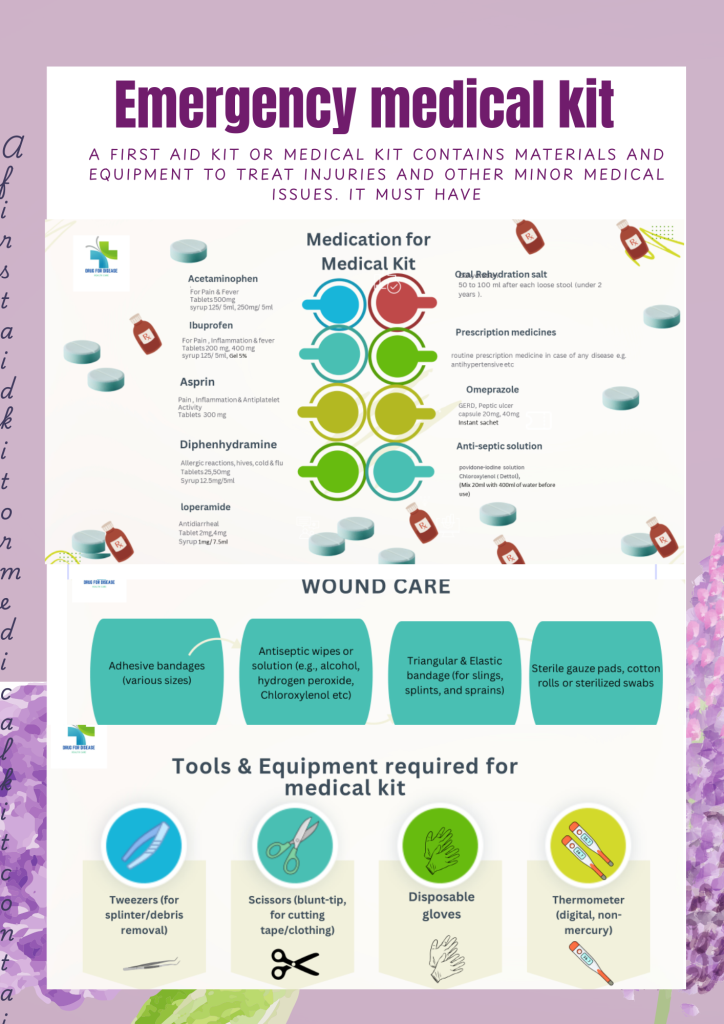First Aid/Emergency Medicines Kit
A first aid kit or medical kit contains materials and equipment to treat injuries and other minor medical issues. First aid kits vary depending on the knowledge and experience of individuals assembling them, the first aid needs of the area where they will be utilised, and local laws and regulations. Packaging options for standard kits typically include sturdy plastic boxes, cloth pouches, or wall-mounted cabinets. The purpose determines the container size, which ranges from wallet to large box. To maintain aseptic conditions, kits should be stored in a clean, dust- and damp-proof container. Make sure to inspect and replace any damaged or expired products in the kits.
First aid or medical emergency kits help prompt responses to injuries.
It helps in preparedness for unforeseen crises, whether at home, in the job, or during travel.
It also stabilises the patient before professional assistance arrives.
Prompt first aid can mitigate the severity of injuries, potentially decreasing the necessity for costly medical intervention and related expenses.
First Aid Kit Checklist
It is to understand what items should be included in an emergency or first aid kit. We divide it as per disease

Wound Care: For wound care, the following items should be included in the kit:
Adhesive tape (medical-grade)
Adhesive bandages (various sizes)
Sterile gauze pads, cotton rolls or sterilized swabs
Antiseptic wipes or solution (e.g., alcohol, hydrogen peroxide)
Antibiotic & steroid ointment for topical application, e.g., polymyxin (polyfax)
Burn gel or burn dressings silver sulfadiazine
Triangular & Elastic bandage (for slings, splints, and sprains)
Tourniquet (for severe bleeding)
Tools & Equipment
Safety pins (to secure bandages)
Tweezers (for splinter/debris removal)
Scissors (blunt-tip, for cutting tape/clothing)
Thermometer (digital, non-mercury)
Disposable gloves
Instant cold packs
Medications It is important to manage the dosage form based on the patient’s age (children, neonates, or adults) and the timing of the medicine purchase.
Pain & fever reducers (e.g., ibuprofen, acetylsalicylic acid or acetaminophen)
Antihistamines (e.g., diphenhydramine )
Aspirin (for heart attack symptoms)
Anti-diarrheal medication (e.g., loperamide)
Laxatives (optional)
You should have personal prescriptions for any health condition, such as blood pressure, arthritis, diabetes mellitus, etc., along with expiration checks.
Povidone-iodine or antiseptic solution, saline, syringes (insulin) or others
ORS (oral rehydration salt) & Hand sanitizer etc.
One must have the above things for a medical emergency; however, food, water, a torch, a lighter for fire, batteries, a knife, and clothes must be kept separate. Place everything in a safe, cool place.
Maintenance Tips
Regularly checking expiry dates and replenishing used items is necessary.
Customise based on household needs (e.g., baby supplies or pet items).
Store in an easily accessible, dry location.
FAQs
What should be included in a basic first aid kit?
A basic kit should have bandages, adhesive tape, antiseptic wipes, antibiotic ointment, sterile gauze, scissors, tweezers, pain relievers, gloves, and a first aid manual.
How often should I check or update my emergency kit?
Check your kit every 6 months to replace expired items and restock supplies that may have been used.
Is it necessary to have a separate first aid kit for the car?
Yes, having a first aid kit in your car ensures you’re prepared for injuries or emergencies while travelling.
Can I use expired items in a first aid kit?
It’s not recommended; expired medications and sterile supplies may lose effectiveness or become unsafe.
Why is it important to have a first aid kit at home and work?
Quick access to a first aid kit can help manage minor injuries immediately and potentially save lives in more serious emergencies.
Conclusion
An emergency kit is a vital tool that can make a significant difference during unexpected situations. It provides the essential supplies needed to treat injuries, manage health conditions, and stay safe until professional help arrives. Having a well-stocked, regularly updated kit at home, work, or in your car ensures you’re prepared to respond quickly and effectively. In emergencies, being prepared isn’t just helpful—it can be lifesaving.
